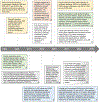Genetic architecture of Tourette syndrome: our current understanding
- PMID: 33612126
- PMCID: PMC10763736
- DOI: 10.1017/S0033291721000234
Genetic architecture of Tourette syndrome: our current understanding
Abstract
Tourette syndrome (TS) is a severe neuropsychiatric disorder characterized by recurrent, involuntary physical and verbal tics. With a prevalence as high as 1% in children, a deeper understanding of the etiology of the disorder and contributions to risk is critical. Here, we cover the current body of knowledge in scientific literature regarding the genetics of TS. We first review the history and diagnostic criteria for TS cases. We then cover the prevalence, and begin to address the etiology of the disorder. We highlight long-standing evidence for a genetic contribution to TS risk from epidemiology studies focused on twins, families, and population-scale data. Finally, we summarize current large-scale genetic studies of TS along specific classes of genetic variation, including common variation, rare copy number variation, and de novo variation that impact protein-coding sequence. Although these variants do not account for the entirety of TS genetic risk, current evidence is clear that each class of variation is a factor in the overall risk architecture across TS cases.
Keywords: TS; Tourette; genetic variants; genetics; genomics; review.
Conflict of interest statement
Conflicts of Interest
The authors have no conflicts of interest to declare.
Figures


References
-
- 125 Years of Tourette Syndrome: The Discovery, Early History and Future of the Disorder. (n.d.). Quarterly Newsletter of the Tourette Association, 38(3). Retrieved from https://tourette.org/resource/125-years-tourette-syndrome-discovery-earl...
-
- American Psychiatric Assocation. (1952). Diagnostic and Statistical Manual of Mental Disorders (1st ed.). American Psychiatric Association.
-
- American Psychiatric Assocation. (2013). Diagnostic and Statistical Manual of Mental Disorders (5th ed.). American Psychiatric Association.
Publication types
MeSH terms
Grants and funding
LinkOut - more resources
Full Text Sources
Other Literature Sources
Medical

